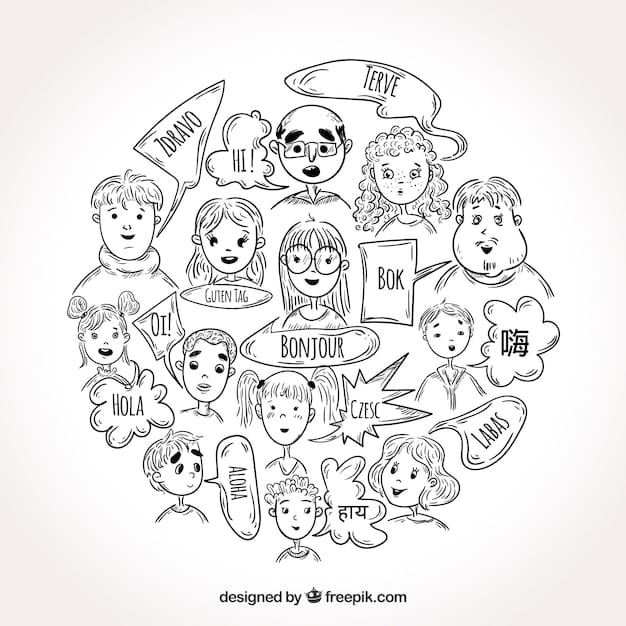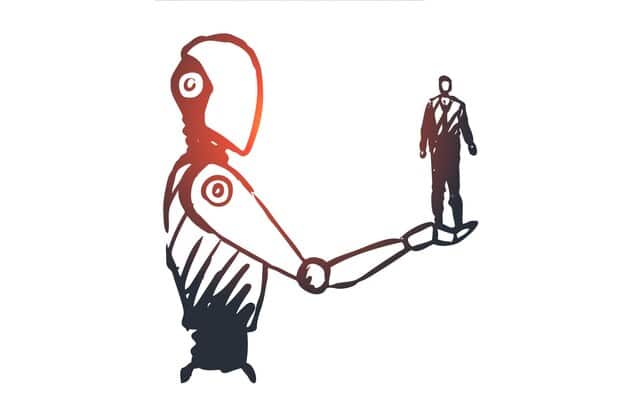Psychology of Rumors: Why False Information Spreads in US

Understanding the psychology of rumors reveals how cognitive biases, emotional states, and social networks combine to accelerate the spread of false information across the US population, often bypassing critical thinking.
In an age saturated with information, both factual and fabricated, the phenomenon of how misinformation takes root and spreads with astonishing speed, particularly in the United States, demands rigorous examination. The Psychology of Rumors: Why False Information Spreads So Quickly in the US delves into the complex interplay of human cognition, emotion, and social dynamics that contribute to this pervasive challenge, exploring the mechanisms that transform whispers into widespread beliefs and reshape collective realities.
The Cognitive Traps: How Our Minds Are Vulnerable to Misinformation
The human brain, while remarkably sophisticated, is also susceptible to certain biases and shortcuts that can inadvertently facilitate the spread of false information. We instinctively seek to make sense of the world, often filling in gaps with readily available, albeit unverified, narratives. This inherent need for coherence can be exploited by rumors, especially when they offer simple, compelling explanations for complex events or anxieties.
One primary cognitive mechanism at play is the confirmation bias, where individuals tend to seek out, interpret, and remember information in a way that confirms their pre-existing beliefs or hypotheses. When a rumor aligns with what someone already believes or wants to believe, they are far more likely to accept it as true without critical scrutiny. This creates echo chambers where misinformation can thrive unchallenged.
Confirmation Bias and Selective Exposure
Confirmation bias is a powerful force in rumor propagation. People actively filter information, paying more attention to content that supports their existing viewpoints. This isn’t necessarily a conscious malicious act; it’s a fundamental aspect of how our brains process information efficiently. However, in the context of rumors, it means that even if evidence contradicting a rumor exists, those predisposed to believe it might never encounter or properly process that counter-evidence.
- Information Filtering: Individuals preferentially consume news and social media content that aligns with their worldview.
- Memory Bias: We are more likely to remember details that confirm our beliefs and forget those that contradict them.
- Interpretive Bias: Ambiguous information is often interpreted in a way that supports existing notions.
Another related factor is the cognitive fluency effect, which suggests that information that is easier to process and understand is often perceived as more credible. Rumors frequently adopt simplistic narratives, devoid of nuance, making them highly “fluent” and therefore more readily accepted than complex, fact-based explanations that require more cognitive effort to comprehend.
In addition, the continued influence effect demonstrates that even after an individual has been told that a piece of information is false, they may continue to use that false information when making judgments or inferences. This is particularly problematic for rumors, as retractions often don’t fully erase the initial impact of the misinformation. The initial exposure leaves a lasting impression, making it difficult to fully dislodge the falsehood from one’s mental framework.
Ultimately, our cognitive architecture, designed for rapid processing and sense-making, can, under certain conditions, become a pathway for the rapid dissemination and entrenchment of false information. Recognizing these inherent biases is the first step in building resilience against the psychological appeal of rumors.
The Emotional Engine: How Feelings Drive Rumor Spread
Beyond cognitive biases, emotions play an incredibly powerful role in the rapid spread of false information. Rumors are often emotionally charged, designed to evoke strong reactions such as fear, anger, hope, or even schadenfreude. When our emotional centers are activated, our rational and critical thinking faculties can be sidelined, making us more susceptible to believing, and subsequently sharing, unverified claims.
Negative emotions, in particular, are potent drivers of rumor propagation. Fear-based rumors, for instance, warning of impending dangers or hidden threats, tap into our primal survival instincts. Such rumors can spread like wildfire, as individuals feel an urgent need to alert others to perceived threats, even if the information lacks corroboration. This innate desire to protect oneself and one’s community can override a careful assessment of facts, prioritizing speed of dissemination over accuracy.
The Role of Anxiety and Uncertainty
In times of high anxiety or uncertainty, rumors provide a sense of control and explanation, even if it’s a false one. During crises, natural disasters, or periods of social upheaval, factual information may be scarce or slow to emerge. In this vacuum, rumors rush in, offering seemingly coherent narratives that help people make sense of bewildering situations. This helps alleviate cognitive dissonance and provides a framework, however flawed, for understanding chaotic events.
- Sense-Making: Rumors offer explanations during ambiguous or confusing times.
- Coping Mechanism: Spreading rumors can be an attempt to cope with fear or helplessness.
- Emotional Contagion: Emotions embedded in rumors can quickly transfer between individuals.
Anger is another significant emotional catalyst. Rumors that vilify a particular group, individual, or institution, especially those that align with pre-existing grievances or political affiliations, can ignite widespread outrage. The act of sharing such a rumor becomes a form of protest or an expression of shared resentment, further amplifying its reach. The emotional intensity often makes people less likely to pause and verify the source or validity of the claim.

On the flip side, positive emotions, like hope or excitement, can also fuel rumor spread. Rumors of breakthroughs, miraculous cures, or impending good news can be shared enthusiastically, driven by a desire for a positive outcome. While seemingly benign, such rumors can still lead to disappointment, false expectations, or even dangerous behaviors if acted upon without verification.
The emotional payload of a rumor is often a key determinant of its virality. Understanding that people are not just rational actors, but also deeply emotional beings, is fundamental to comprehending why false information can spread with such remarkable speed, especially in a digitally connected world that amplifies emotional responses.
The Social Fabric: Networks and Homophily in Rumor Transmission
False information does not spread in a vacuum; it flourishes within social networks, leveraging the very connections that bind us. The structure and dynamics of these networks, both online and offline, play a critical role in how quickly and widely rumors disseminate. Our tendency to connect with people similar to ourselves, a phenomenon known as homophily, further exacerbates this issue.
Social networks act as conduits for information, whether accurate or not. Within these networks, information transmission is often governed by trust. We are more likely to believe and share information that comes from someone we know and trust – a friend, family member, or respected figure within our community. This personal endorsement bypasses the critical scrutiny often applied to unfamiliar sources.
Echo Chambers and Filter Bubbles
Online platforms have amplified this effect through the creation of “echo chambers” and “filter bubbles.” Algorithms designed to personalize our feeds by showing us content we are likely to engage with inadvertently reinforce our existing beliefs and expose us primarily to like-minded individuals. When a rumor enters such a bubble, it rarely encounters contradictory information, allowing it to circulate freely and gain legitimacy through repetition within the insulated group.
- Algorithmic Reinforcement: Social media algorithms can prioritize content that reinforces existing beliefs.
- Groupthink: Cohesive groups may suppress dissenting opinions, enhancing belief in rumors.
- Social Legitimacy: When peers share a rumor, it gains perceived legitimacy within the group.
Homophily, the principle that “birds of a feather flock together,” means that our social ties are often with people who share our demographic characteristics, political leanings, and cultural values. This creates homogenous networks where rumors that align with the group’s collective identity or grievances are particularly likely to spread. A rumor that might be dismissed in a diverse group could gain significant traction within a homophilous network precisely because it resonates with shared predispositions and strengthens group identity.
The speed of social media platforms further accelerates rumor transmission. The ease of sharing—a single click—reduces the friction typically involved in disseminating information. This low barrier to entry means that unverified claims can reach millions in minutes, long before fact-checkers can intervene or corrections can catch up. The desire for social validation, the urge to be “in the know,” or to be the first to share “important” news also contributes to this rapid spread, often neglecting the paramount need for accuracy.
In essence, the very architecture of our social connections, both inherent in our human nature and amplified by digital platforms, can transform into superhighways for the rapid, uncritical spread of false information, making society’s collective immune system vulnerable to the viral nature of rumors.
The Role of Authority and Credibility in Believability
While emotions and social networks significantly impact rumor spread, the perceived credibility of the source, or the authority invoked by the rumor, plays a crucial role in its believability and rapid dissemination. People often rely on heuristics – mental shortcuts – to assess information, and one common heuristic is to evaluate the source. When a rumor appears to originate from, or be endorsed by, an authority figure or a seemingly credible institution, its perceived truthfulness skyrockets.
This reliance on authority can be exploited by purveyors of false information. Rumors often masquerade as “insider” information, claiming to come from unnamed officials, whistleblowers, or experts. Even if these claims are entirely fabricated, the mere implication of an authoritative source lends the rumor an air of legitimacy. This is particularly effective when the rumor preys on existing distrust of established institutions, positioning itself as the “real truth” that the authorities are trying to suppress.
Source Credibility and Trust
In the US, where trust in traditional media and government institutions has fluctuated in recent years, the landscape for rumor spread is particularly fertile. When trust erodes, people seek alternative sources of information, often turning to individuals or platforms that align with their existing beliefs, regardless of their actual expertise or factual accuracy. A charismatic individual with a large following on social media, for instance, can be perceived as a more credible source than a mainstream news organization by certain segments of the population.
- Source Heuristic: People quickly judge information based on perceived source authority.
- Trust Vacuum: Low trust in traditional sources creates an opening for alternative narratives.
- Opinion Leaders: Influential individuals within social circles can legitimate rumors.
The concept of “illusory truth effect” also comes into play here: repeating information, even if false, makes it seem more true over time. When a rumor, initially presented through a seemingly authoritative channel, is then repeated across various social platforms and by multiple individuals, its perceived validity increases. The sheer volume of repetition creates a sense of familiarity, which is often mistaken for accuracy. This is why disclaimers and fact-checks often struggle to fully undo the damage of an initial, authoritative-sounding false claim.

Furthermore, propaganda and disinformation campaigns strategically exploit this by creating seemingly legitimate-looking websites, social media accounts that mimic official sources, or even deepfake videos that convincingly portray public figures delivering false statements. These sophisticated tactics blur the lines between genuine authority and manufactured credibility, making it incredibly challenging for the average person to discern truth from falsehood, thereby accelerating the spread of deceptive narratives.
Understanding how perceived authority can be manipulated is critical to combating the rapid proliferation of rumors. It underscores the need for robust media literacy and a healthy skepticism towards information, even when it appears to come from seemingly trustworthy channels.
The Information Landscape: Speed, Volume, and Verification Challenges
The modern information landscape, characterized by unprecedented speed and sheer volume, is perhaps the single most significant factor in the rapid spread of false information. In the US, as in many developed nations, the omnipresence of digital devices and the 24/7 news cycle have created an environment where information, true or false, circulates globally within seconds, posing immense challenges to verification and containment.
The speed of dissemination is astounding. Before the digital age, rumors typically spread through word of mouth, requiring physical proximity or limited telecommunications. Today, a single tweet or Facebook post can reach millions instantly. This “real-time” information flow means that a false narrative can be fully entrenched in public consciousness long before traditional fact-checking processes can even begin to assess its validity. The lag between assertion and verification has become a critical vulnerability.
Information Overload and Cognitive Strain
Compounding the speed is the sheer volume of information. We are constantly inundated with data from countless sources – news websites, social media feeds, messaging apps, and personal contacts. This information overload creates cognitive strain, making it difficult for individuals to critically evaluate every piece of content they encounter. In this environment, people are more likely to rely on quick judgments, emotional responses, or the superficial credibility of a source, rather than engaging in deep, analytical processing.
- Real-time Diffusion: Digital platforms enable instant global information spread.
- Attention Economy: Competition for attention favors sensational or emotionally charged content.
- Information Asymmetry: False information can be created faster than it can be debunked.
The gatekeepers of information—traditional media outlets—have also seen their role change. While still important, their centralized authority has been diluted by citizen journalism, social media influencers, and alternative news sites, some of which operate with little to no editorial oversight. This decentralization of information production means there are fewer established filters to prevent the spread of unverified claims at the source.
Furthermore, the economic incentives of the digital age often favor virality over accuracy. Content that generates strong emotional responses, regardless of its truthfulness, tends to attract more clicks, shares, and engagement, which translates into advertising revenue for platforms and visibility for creators. This inadvertently incentivizes the production and dissemination of sensational, often false, narratives.
The asynchronous nature of corrections further contributes to the problem. While a rumor can spread virally and instantly, corrections and retractions often lag far behind, reaching a smaller audience and lacking the emotional punch of the original falsehood. Once a false narrative has taken root, it is incredibly difficult to fully displace, even with overwhelming evidence to the contrary. The sheer scale and velocity of the modern information ecosystem present an unprecedented challenge in maintaining a well-informed public in the US.
Combating the Spread: Strategies for Resilience and Critical Engagement
Given the complex psychological, emotional, social, and technological factors driving the spread of false information, combating rumors requires a multi-pronged approach focused on building individual and societal resilience. There is no single silver bullet, but rather a combination of strategies that empower individuals and platforms to better navigate the treacherous information landscape.
One crucial strategy is enhanced media literacy education. Equipping individuals, especially younger generations, with the skills to critically evaluate sources, recognize common cognitive biases, and understand the mechanisms of online disinformation is paramount. This involves teaching people how to identify sensational language, verify facts with independent sources, and recognize propaganda techniques. Such education should be integrated into curricula and promoted through public awareness campaigns.
Developing Critical Information Consumption Habits
Promoting critical information consumption habits is key. This includes encouraging people to:
- Pause and Verify: Before sharing, take a moment to cross-reference information with reliable sources.
- Consider the Source: Evaluate the credibility, expertise, and potential biases of the information origin.
- Recognize Emotional Triggers: Be aware when a piece of information is designed to provoke strong emotions, as this often indicates manipulative intent.
Technology platforms also bear a significant responsibility. This includes implementing more robust fact-checking partnerships, developing clearer labels for unverified or false content, and modifying algorithms to prioritize accuracy over engagement when necessary. While challenging, platforms must find a balance between free expression and the societal harm caused by rampant misinformation. This could involve downranking or limiting the spread of verified false information, without outright censorship.
Furthermore, supporting independent journalism and robust public broadcasting is vital. High-quality, evidence-based journalism serves as a crucial bulwark against misinformation by providing reliable alternatives and conducting thorough investigations. Funding for investigative journalism and local news, both of which have been challenged in recent years, is essential for a healthy information ecosystem.
Lastly, fostering open and respectful dialogue about difficult topics can help. When people feel heard and understood, they are less likely to seek out extreme or conspiratorial narratives that confirm their perceived grievances. Building bridges across ideological divides can reduce the polarization that often fuels the “us vs. them” mentality exploited by rumor mongers. While the rapid spread of false information is a daunting challenge for the US, a concerted effort across education, technology, media, and civil society can foster a more informed and resilient public.
The Psychological Impact: Erosion of Trust and Social Cohesion
The rapid and widespread dissemination of false information, fueled by the psychological mechanisms discussed, extends its impact far beyond merely misinforming individuals. Its insidious effects ripple through society, subtly eroding trust, fracturing social cohesion, and posing significant risks to democratic processes and public health in the US. The psychological toll of living in an environment where truth is constantly contested is profound.
One of the most damaging consequences is the erosion of trust in institutions. When false rumors repeatedly target governments, scientific bodies, media organizations, or public health agencies, it sows widespread doubt about their credibility and intentions. This distrust makes it incredibly difficult for these institutions to communicate effectively, especially during crises when accurate information is paramount. For example, health-related misinformation can directly lead to adverse public health outcomes if people act on false cures or disbelieve legitimate medical advice.
Societal Polarization and Disorientation
Rumors often capitalize on existing societal divisions, exacerbating polarization. By demonizing opposing groups or fabricating narratives of injustice, false information can deepen partisan divides and foster animosity. This leads to a fragmented society where different groups operate with entirely different sets of “facts,” making common ground and constructive dialogue increasingly difficult. The psychological discomfort of this disorientation can lead people to cling even more tightly to their preferred narratives, true or false.
- Institutional Distrust: Rumors undermine public faith in established authorities.
- Social Fragmentation: Misinformation deepens divides between different societal groups.
- Decision Paralysis: Contradictory information can lead to inaction or misguided choices.
Moreover, the constant exposure to contradictory information, conspiracy theories, and fact-checks can lead to a state of information fatigue and cynicism. People can become overwhelmed and simply disengage, or they might adopt a nihilistic view that “nothing is true anyway,” making them susceptible to whatever narrative feels most convenient or emotionally satisfying. This ‘truth apathy’ is a dangerous outcome for any well-functioning society, as it disincentivizes critical thinking altogether.
The psychological impact also manifests on an individual level. People who fall victim to believing and acting upon false information can experience economic losses, social isolation, or even physical harm. The shame of being deceived can also lead individuals to double down on their false beliefs, rather than admitting they were wrong, further entrenching the misinformation.
In essence, the spread of rumors is not merely an inconvenience; it is a profound psychological weapon that undermines the very fabric of healthy societies. Understanding its multifaceted impact is essential for developing comprehensive strategies to repair trust, bridge divides, and fortify the collective ability of the US population to discern truth from falsehood.
| Key Factor | Brief Description |
|---|---|
| 🧠 Cognitive Biases | Our mental shortcuts (e.g., confirmation bias) make us prone to accepting information aligning with existing beliefs, often without critical evaluation. |
| ❤️ Emotional Triggers | Rumors often tap into strong emotions like fear or anger, overriding rational thought and prompting rapid sharing. |
| 🌐 Social Networks | Homophily and echo chambers amplify rumors within like-minded groups, spreading false data through trusted connections. |
| ⚡ Speed & Volume | The sheer speed and volume of digital information overwhelm critical vetting, allowing falsehoods to become entrenched before debunking. |
Frequently Asked Questions About Rumor Psychology
▼
This phenomenon, known as the “continued influence effect,” occurs because initial information, even if false, quickly establishes a coherent narrative. Correcting it requires more cognitive effort to update that narrative. Moreover, the original false information often comes with emotional weight, which is harder to undo with dry facts, or it might align with existing beliefs, making people resistant to new, contradictory truths.
▼
Social media algorithms are designed to maximize engagement, often by showing users content they are most likely to interact with. This creates “filter bubbles” and “echo chambers” where users are primarily exposed to information that confirms their existing beliefs. If a rumor enters such a bubble, it can spread rapidly and gain perceived legitimacy through repeated exposure from like-minded connections, bypassing diverse perspectives or fact-checks.
▼
Research suggests that negative emotions (e.g., fear, anger, disgust) motivate greater psychological engagement and sharing than positive emotions. Rumors that trigger these strong negative feelings often tap into our survival instincts or grievances, making them highly viral. While positive rumors can spread, intensely negative ones typically generate more immediate and widespread dissemination due to their emotional potency and perceived urgency.
▼
Uncertainty creates an urgent need for explanation and control. In situations where official information is scarce or confusing, rumors step in to fill the informational void. They provide a seemingly coherent narrative, however false, that helps people make sense of ambiguous or stressful circumstances. This reduces cognitive dissonance and psychological discomfort, making people more receptive to quick, albeit unverified, explanations.
▼
Developing resilience involves practicing critical thinking and media literacy. Strategies include: pausing before sharing to verify information, checking multiple credible sources, recognizing emotional manipulation, being aware of one’s own biases (like confirmation bias), and understanding how algorithms work. Being skeptical of sensational headlines and being willing to update one’s beliefs in light of new evidence are crucial steps.
Conclusion: Building a Resilient Information Society
The rapid spread of false information in the US is not merely a technical challenge but a deeply rooted psychological and social phenomenon. It thrives on our cognitive biases, is amplified by our emotions, spreads through our social connections, and is accelerated by the sheer velocity and volume of the digital information age. Understanding these underlying psychological mechanisms is the cornerstone of any effective counter-strategy. By fostering greater media literacy, promoting critical thinking, encouraging responsible platform stewardship, and rebuilding trust in verified sources, society can begin to inoculate itself against the seductive power of rumors, paving the way for a more informed and cohesive public sphere.





